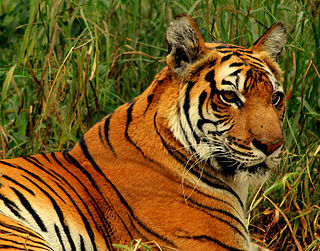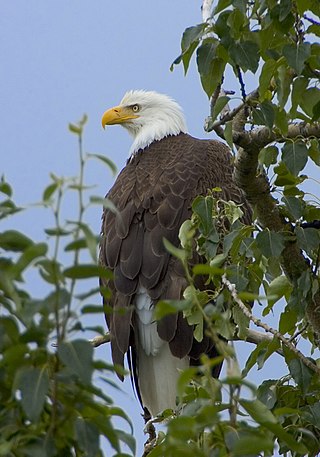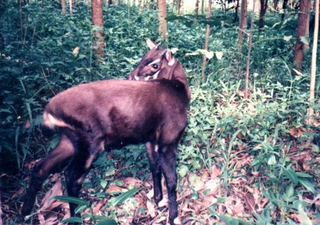Fauna
Mammals




There are 264 mammal species in Thailand on the IUCN Red List. Of these species, three are critically endangered, 24 are vulnerable, and two are near-threatened. One of the species listed for Thailand is considered to be extinct. [1]
- Agile gibbon
- Asian golden cat
- Asiatic black bear
- Banded linsang
- Banded palm civet
- Banteng
- Binturong
- Back-striped weasel
- Bumblebee bat
- Clouded leopard
- Colugo
- Common treeshrew
- Common dolphin
- Crab-eating mongoose
- Cuvier's beaked whale
- Dwarf sperm whale
- European otter
- False killer whale
- Fea's muntjac
- Finless porpoise
- Fishing cat
- Flat-headed cat
- Fraser's dolphin
- Ginkgo-toothed beaked whale
- Siamese jackal
- Gaur
- Gray goral
- Hairy-nosed otter
- Hog badger
- Hog deer
- Humpback dolphin
- Indian elephant
- Indian muntjac
- Indochinese leopard
- Indochinese tiger
- Irrawaddy dolphin
- Jungle cat
- Kouprey
- Lar gibbon
- Large Indian civet
- Large-spotted civet
- Leopard cat
- Lesser false vampire bat
- Malayan tapir
- Malayan tiger
- Marbled cat
- Masked palm civet
- Melon-headed whale
- Northern short-tailed gymnure
- Northern Sumatran rhinoceros
- Northern treeshrew
- Oriental small-clawed otter
- Otter civet
- Pantropical spotted dolphin
- Pileated gibbon
- Pilot whale
- Pteropus
- Pygmy killer whale
- Pygmy sperm whale
- Rice-field rat
- Rough-toothed dolphin
- Sambar deer
- Schomburgk's deer
- Siamang
- Siberian weasel
- Small Asian mongoose
- Small Indian civet
- Small-toothed palm civet
- Spinner dolphin
- Spotted linsang
- Spotted-winged fruit bat
- Striped dolphin
- Sun bear
- Sunda pangolin
- Ussuri dhole
- Vietnamese Javan rhinoceros
- Water buffalo
Fish
- Asian arowana
- Blackline rasbora
- Channa lucius
- Channa striata
- Climbing gourami
- Croaking gourami
- Devario laoensis
- Dwarf gourami
- Fire bar danio
- Giant barb
- Giant freshwater stingray
- Giant gourami
- Harlequin rasbora
- Himantura kittipong
- Kissing gourami
- Pearl gourami
- Penang betta
- Fiveband barb
- Puntius partipentazona
- Six-banded tiger barb
- Pygmy gourami
- Red-tailed black shark
- Siamese algae eater
- Siamese fighting fish
- Spotted barb
- Three spot gourami
- Walking catfish
Amphibians
Reptiles
- Ahaetulla nasuta
- Amphiesma stolatum
- Acrochordus granulatus
- Batagur baska
- Bengal monitor
- Blood python
- Boiga cyanea
- Boiga dendrophila
- Boiga drapiezii
- Boiga jaspidea
- Boiga multomaculata
- Boiga nigriceps
- Brahminy blind snake
- Bufo asper
- Burmese python
- Calotes emma
- Cantoria violacea
- Cerberus rynchops
- Chinese water dragon
- Chrysopelea ornata
- Cnemaspis kandiana
- Cuora amboinensis
- Dendrelaphis caudolineatus
- Dixonius siamensis
- Draco blanfordii
- Draco maculatus
- Duttaphrynus melanostictus
- Elaphe porphyracea
- Enhydris enhydris
- False gharial
- Fejervarya limnocharis
- Fordonia leucobalia
- Gekko smithii
- Gerarda prevostiana
- Giant Asian pond turtle
- Gonyosoma oxycephalum
- Green sea turtle
- Hawksbill turtle
- Hemidactylus brookii
- Hemidactylus garnotii
- Homalopsis buccata
- House gecko
- Hydrophis klossi
- Hydrophis spiralis
- Indian python
- Indotestudo elongata
- King cobra
- Leatherback sea turtle
- Leptobrachium smithi
- Lycodon aulicus
- Lycodon fasciatus
- Manouria emys
- Microhyla berdmorei
- Microhyla ornata
- Microhyla pulchra
- Naja kaouthia
- Oligodon cinereus
- Oligodon cyclurus
- Oligodon dorsalis
- Pelochelys cantorii
- Psammophis condanarus (sand snake)
- Ptychozoon kuhli
- Ptychozoon lionotum
- Pyxidea mouhotii
- Reticulated python
- Saltwater crocodile
- Scaphiophryne gottlebei
- Siamese crocodile (Critically endangered and on the IUCN Red List)
- Spiny turtle
- Takydromus sexlineatus
- Tokay gecko
- Trimeresurus gramineus
- Trimeresurus popeiorum
- Trimeresurus purpureomaculatus
- Trimeresurus stejnegeri
- Tropidolaemus wagleri
- Varanus salvator
- White-banded wolf snake
Birds

The birds of Thailand number nearly one thousand species, of which approximately 45 are rare or accidental. At least seven bird species previously found in Thailand have since been made locally extinct, and approximately fifty of Thailand's bird species are globally threatened. [2]
In 1991, it was estimated that 159 resident and 23 migratory species were endangered or vulnerable due to forest clearance, illegal logging, hunting and habitat degradation, especially in the lowlands. The species most affected are large water birds whose wetland habitat has been largely lost to agriculture, and forest species, as deforestation for agriculture and logging have removed and degraded portions of the woodlands. [3]
Insects
Ants
Butterflies
There are about 1,100 known butterfly species from Thailand. [4]
Molluscs
There are at least 23 known families, 57 genera and 125 species of land gastropods from Eastern Thailand. [5]
There are at least 8 known species of freshwater gastropods and at least 2 species of freshwater bivalves from the Sakaeo Province in the Eastern Thailand. [6]








